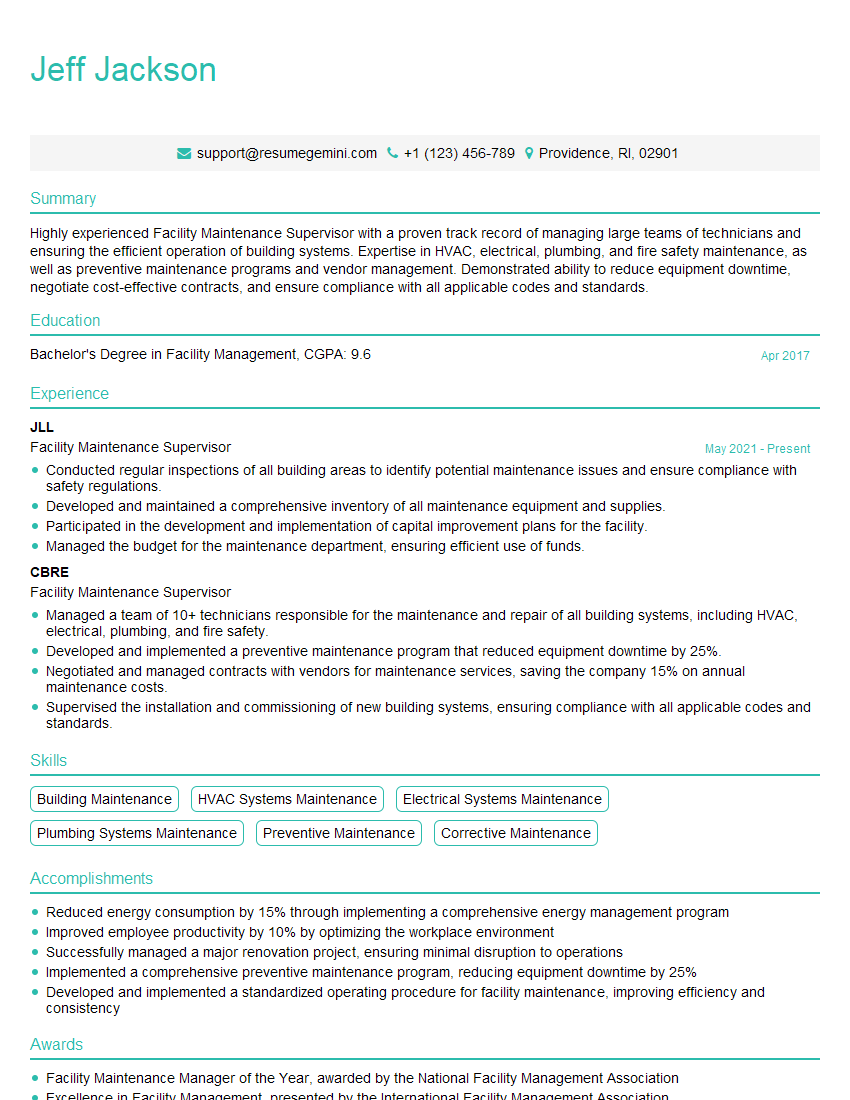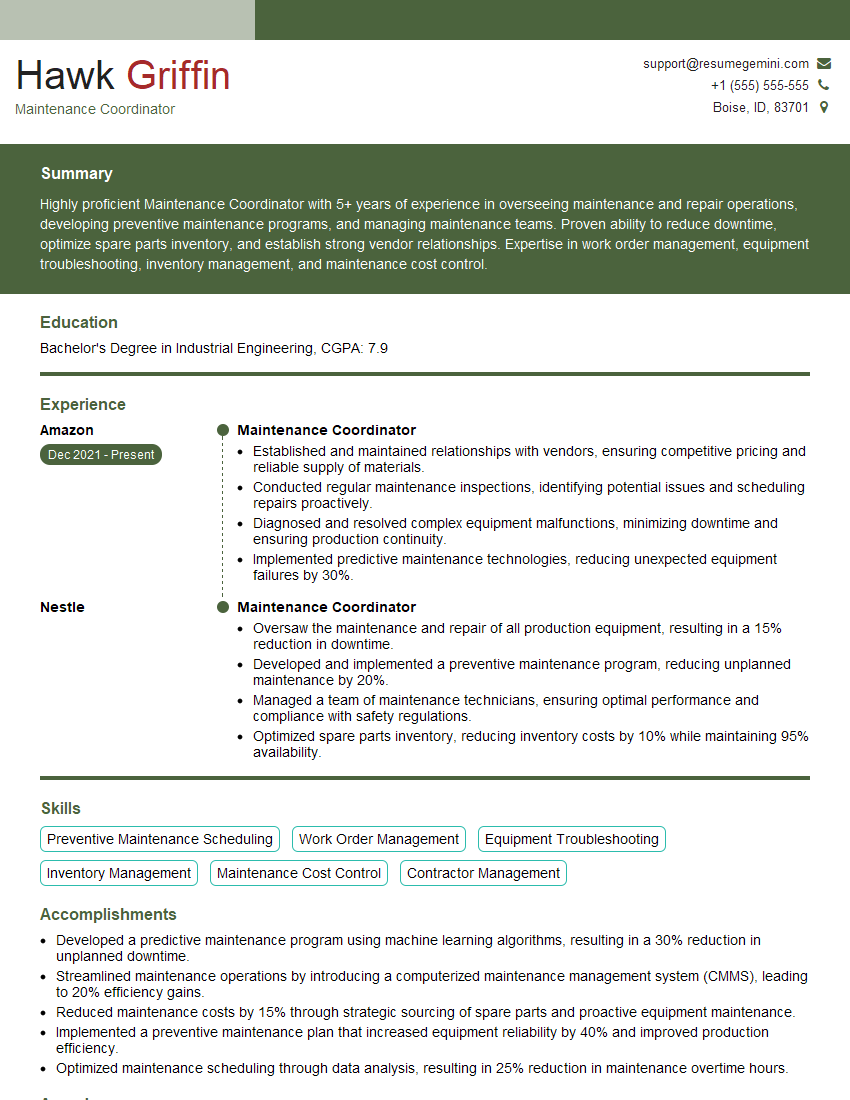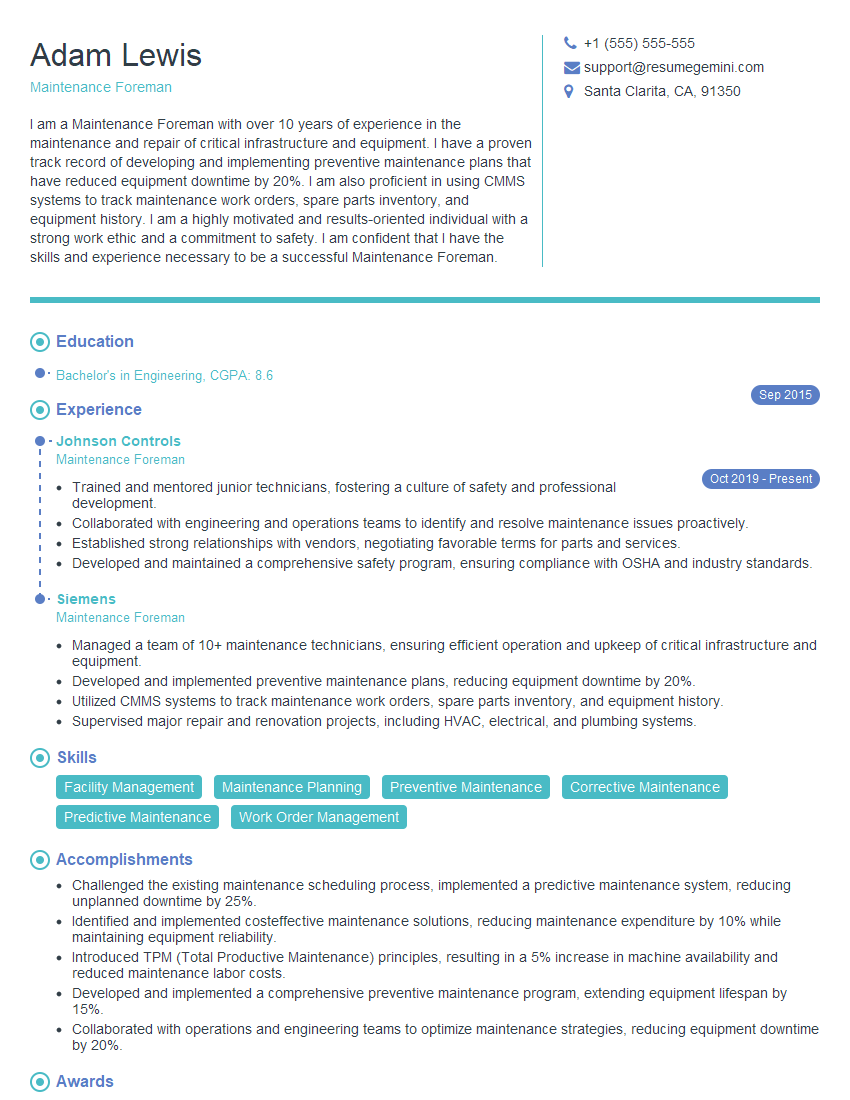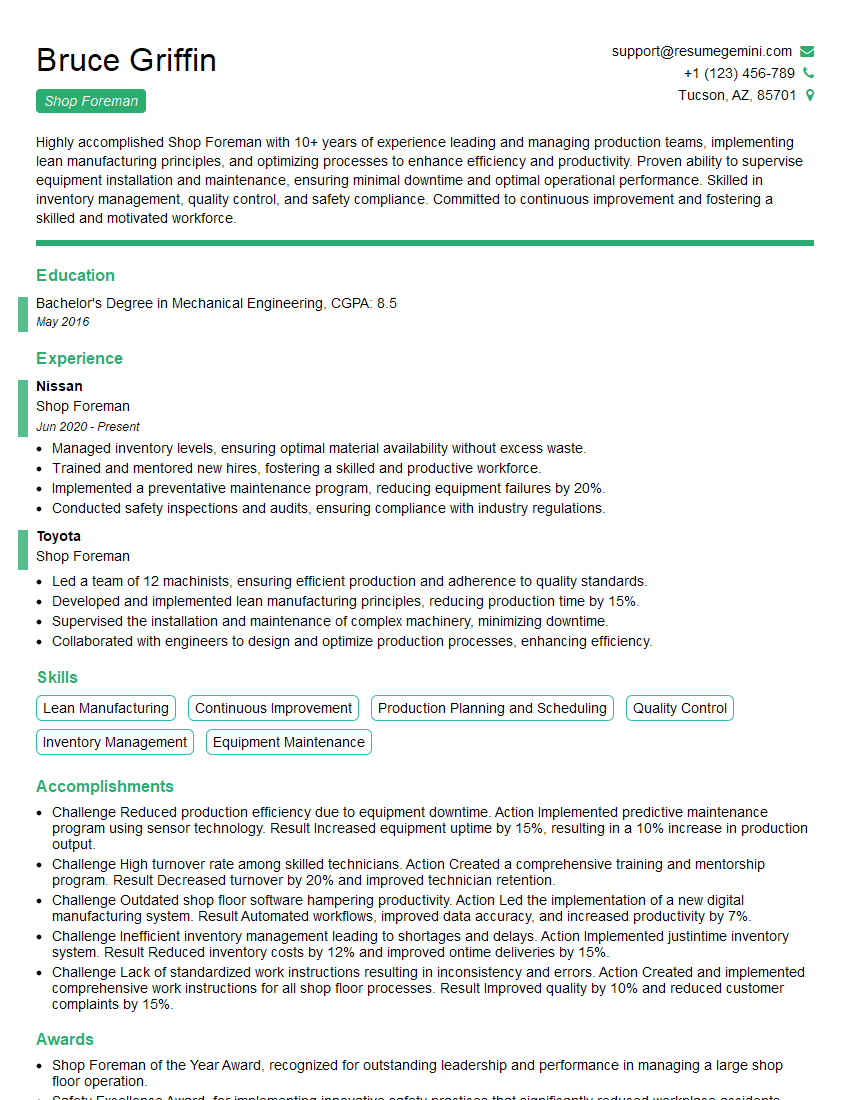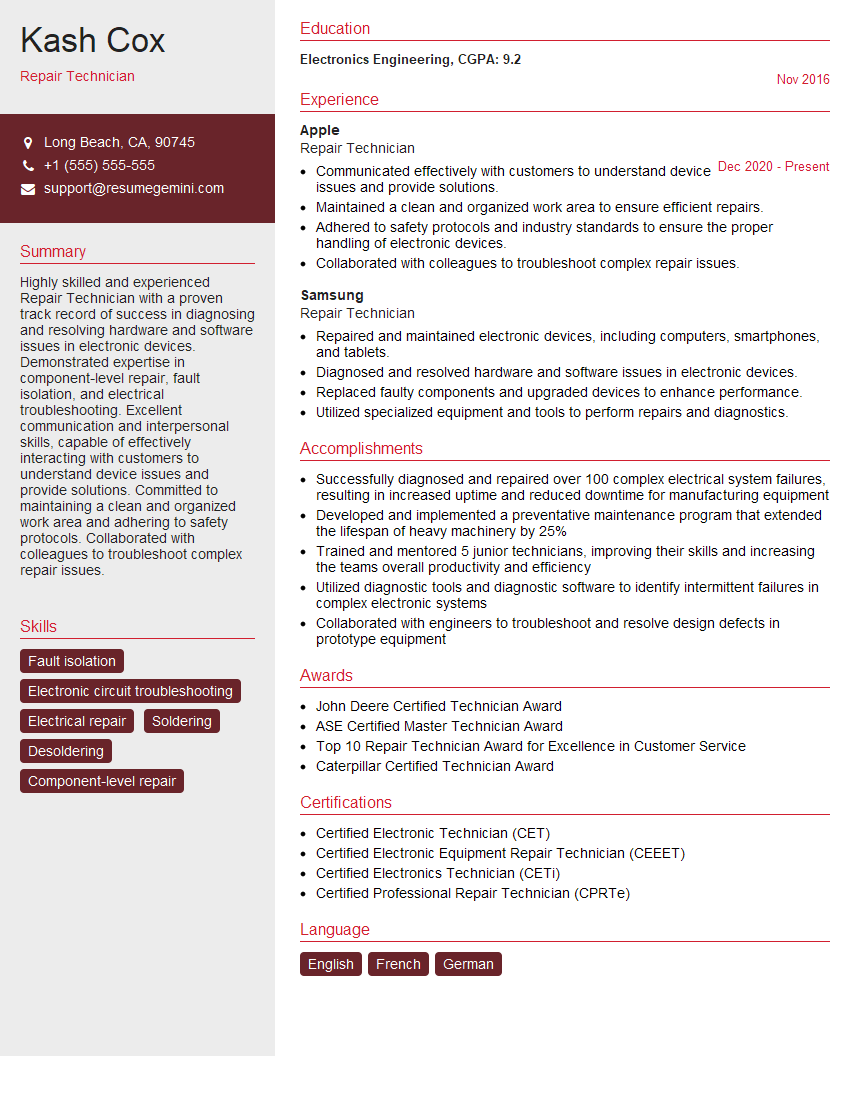Cracking a skill-specific interview, like one for Use maintenance and repair procedures, requires understanding the nuances of the role. In this blog, we present the questions you’re most likely to encounter, along with insights into how to answer them effectively. Let’s ensure you’re ready to make a strong impression.
Questions Asked in Use maintenance and repair procedures Interview
Q 1. Describe your experience with preventive maintenance procedures.
Preventive maintenance is all about proactively addressing potential issues before they become major problems. Think of it like regular check-ups at the doctor – far better to catch something small before it turns into a serious illness. My experience encompasses developing and implementing comprehensive preventive maintenance schedules across various equipment types. This includes tasks like lubrication, inspections, cleaning, and minor adjustments. For example, in a manufacturing setting, I’ve developed a schedule for our robotic arm that includes weekly lubrication of joints, monthly electrical checks, and quarterly safety inspections. This significantly reduces downtime and extends the life of the equipment. I also track the effectiveness of these schedules through data analysis, making adjustments to optimize preventative measures and minimize operational disruptions.
Another example involves the HVAC systems in a large office building. We implemented a program that includes filter changes every three months, condenser coil cleaning twice a year, and yearly comprehensive inspections of the entire system. This ensures consistent climate control, improved energy efficiency, and reduced repair costs. The key is meticulous record-keeping and a robust system to ensure timely execution of all scheduled tasks.
Q 2. Explain your process for troubleshooting equipment malfunctions.
Troubleshooting equipment malfunctions follows a structured approach. I start by gathering information; this includes observing the problem, listening for unusual sounds, and checking for error codes or indicator lights. Then, I systematically check the most likely causes, based on my experience and knowledge of the equipment. My approach often uses a ‘divide and conquer’ strategy where I isolate the problem area, which is analogous to a detective narrowing down suspects. For example, if a conveyor belt stops working, I would first check power supply, then motor operation, then the belt itself for damage or obstructions, and finally the control system. I thoroughly document each step, recording findings and actions taken.
If the problem persists, I consult manuals, schematics, and even reach out to manufacturers or colleagues for assistance. I find using a decision tree or flow chart can really streamline this process. I always ensure safety is the top priority during troubleshooting; if I suspect a safety hazard, I immediately shut down the equipment and report it. Ultimately, effective troubleshooting is a blend of technical knowledge, methodical approach, and problem-solving skills, where the goal is a swift and safe return to full operational functionality.
Q 3. How do you prioritize maintenance tasks?
Prioritizing maintenance tasks requires a multi-faceted approach. I use a combination of factors, including criticality, frequency of use, potential impact of failure, and cost of repair. I use a system that assigns a weighted score to each task based on these factors. For example, a critical piece of equipment in continuous operation gets a high priority, while a less-used machine with readily available replacement parts might receive a lower priority. This prioritization ensures that essential equipment receives timely attention and prevents significant disruptions.
I also use CMMS (Computerized Maintenance Management Systems) software, which assists in scheduling, tracking, and reporting on these tasks. Furthermore, I regularly review and update the priority matrix based on operational changes, equipment condition, and historical data. The goal is a dynamic system that adapts to evolving needs, ensuring optimal resource allocation and proactive risk management.
Q 4. What are your experience with CMMS (Computerized Maintenance Management Systems)?
I have extensive experience with CMMS software, including several industry-leading platforms. My expertise spans data entry, task scheduling, work order management, inventory tracking, and generating reports. I can proficiently use CMMS to track preventive maintenance schedules, manage work orders for repairs, and generate reports on equipment performance and maintenance costs. This allows for better resource allocation, cost control, and improved decision-making.
For instance, I’ve used CMMS to optimize the preventative maintenance schedule for a fleet of delivery trucks, reducing maintenance costs by 15% and improving vehicle uptime by 10%. The software facilitated a systematic approach to managing maintenance, alerting technicians to required tasks, tracking parts inventory, and creating comprehensive reports to improve efficiency. My proficiency in CMMS ensures a smooth and data-driven maintenance process.
Q 5. Describe a time you had to perform emergency repairs.
During a severe winter storm, a critical piece of production equipment—a large industrial freezer—malfunctioned, threatening significant product loss. The temperature started to rise rapidly. My immediate response involved assessing the situation quickly. I identified the failing compressor, a critical component. Due to the urgency, I worked quickly and methodically to isolate the problem, taking the necessary safety precautions and obtaining the required safety approvals. Safety was my top priority.
We located a replacement compressor in our spares inventory and, with the help of my team, replaced the faulty one. I followed the manufacturer’s instructions precisely, ensuring proper installation and connections. We successfully restored the freezer to its operational temperature within two hours, minimizing product damage and potential financial losses. The experience highlighted the importance of having backup plans, a well-stocked spare parts inventory, and a team prepared to act decisively in emergency situations.
Q 6. How do you ensure the safety of yourself and others during maintenance activities?
Safety is paramount in all maintenance activities. I adhere strictly to all safety protocols, including lockout/tagout procedures to prevent accidental start-ups, using appropriate personal protective equipment (PPE) such as safety glasses, gloves, and hearing protection, and following all relevant safety regulations and company policies. Before commencing any maintenance task, I conduct a thorough risk assessment and identify potential hazards. I then take steps to mitigate those hazards.
Furthermore, I communicate clearly with my team and any other personnel in the area. This includes informing them of planned maintenance work and any associated risks. I also ensure the workspace is properly secured and well-lit, and that all tools and equipment are in good working order. Regular training and refresher courses on safety procedures are crucial to maintaining a safe working environment. The goal is to create a culture of safety where proactive measures prevent accidents, reducing risks for myself and others.
Q 7. What types of maintenance documentation are you familiar with?
I’m familiar with a wide range of maintenance documentation, including preventive maintenance schedules, work orders, repair reports, inspection reports, equipment manuals, schematics, parts lists, and safety data sheets (SDS). Preventive maintenance schedules outline routine tasks for equipment maintenance, while work orders detail repairs or modifications done on equipment. Repair reports document the details of repairs completed, including parts used and time spent. Inspection reports record the findings of periodic equipment inspections. Equipment manuals provide operating and maintenance instructions for the equipment.
Schematics offer visual representations of the equipment’s components and their connections. Parts lists document all the components required for the equipment. Finally, safety data sheets provide vital information on the safe handling, storage, and use of hazardous materials used in maintenance activities. Accurate and thorough documentation is essential for tracking maintenance history, identifying trends, improving efficiency, and ensuring regulatory compliance.
Q 8. How do you handle unexpected equipment failures?
Unexpected equipment failures are an inevitable part of any operational environment. My approach involves a structured, prioritized response. First, I ensure the safety of personnel and the prevention of further damage. This might involve immediately isolating the faulty equipment or area. Second, I conduct a rapid assessment to determine the extent of the failure and any immediate risks. This involves visual inspection and checking for obvious causes. Third, I prioritize the issue based on its criticality. A complete shutdown of a critical system requires immediate attention, while a minor malfunction in a non-critical component might have a lower priority. Finally, I initiate corrective action: This could range from simple repairs I can perform myself to calling in specialized technicians or ordering replacement parts. Documentation is crucial at every stage, including the initial assessment, the steps taken, and the resolution. For instance, during a recent unexpected server failure, I immediately switched to the backup system, preventing any major service disruption. Then, I thoroughly documented the failure, investigated the logs, and worked with the IT vendor to diagnose and resolve the root cause – a failing power supply.
Q 9. What is your experience with different types of maintenance (preventive, predictive, corrective)?
My experience encompasses all three major types of maintenance: preventive, predictive, and corrective. Preventive maintenance focuses on scheduled inspections and servicing to prevent failures before they occur. Think of it like regular oil changes for a car – it extends the lifespan and reduces the likelihood of major breakdowns. I have extensive experience developing and implementing preventive maintenance schedules, using CMMS (Computerized Maintenance Management System) software to track tasks and ensure timely completion. Predictive maintenance utilizes data analysis and advanced sensors to predict potential failures before they occur. This is proactive and often employs technologies like vibration analysis or thermal imaging. I’ve used predictive methods on industrial machinery, where detecting anomalies early saved considerable downtime and repair costs. Corrective maintenance, or ‘reactive’ maintenance, addresses failures after they occur. While often less efficient, it’s a necessary component of maintenance. It requires a strong ability to diagnose problems quickly and efficiently, which I’ve honed through years of experience. I am skilled in troubleshooting complex equipment and finding cost-effective solutions. For example, a predictive analysis of pump vibration identified an impending bearing failure weeks before it actually occurred, allowing for a scheduled replacement and avoiding a costly emergency shutdown.
Q 10. Explain your understanding of Root Cause Analysis.
Root Cause Analysis (RCA) is a systematic approach to identifying the underlying causes of problems, not just the symptoms. My understanding of RCA involves using various techniques such as the ‘5 Whys’ method, fault tree analysis, or fishbone diagrams. The goal is to delve deeper than the immediate issue and uncover the fundamental causes that led to the failure. This prevents simply fixing the immediate problem and facing the same issue later. A structured RCA process involves gathering data from various sources, including maintenance logs, operator reports, and technical documentation. After systematically analyzing this information, I develop a detailed root cause analysis report, identifying the root causes and suggesting corrective actions to prevent recurrence. For example, if a production line stops due to a motor failure, a simple RCA might just replace the motor (symptom). However, a thorough RCA might reveal that the motor failure was due to a voltage surge, which was a result of insufficient grounding (root cause). Addressing the grounding issue permanently solves the problem.
Q 11. How do you stay up-to-date with the latest maintenance techniques and technologies?
Staying current in the field of maintenance requires continuous learning. I actively participate in professional organizations, attend industry conferences and workshops, and read relevant trade publications. I also leverage online resources, such as technical journals and webinars, to stay informed about the latest advancements. Further, I actively seek training opportunities, particularly focusing on new technologies like IoT sensors for predictive maintenance and advanced diagnostic tools. Certification programs also demonstrate commitment to professional development. For instance, I recently completed a course on advanced vibration analysis techniques, which significantly enhanced my predictive maintenance capabilities. This continuous learning allows me to adopt the best practices and most efficient techniques in my work.
Q 12. Describe your experience with different types of tools and equipment.
My experience spans a wide range of tools and equipment. This includes hand tools such as wrenches, screwdrivers, and measuring instruments, as well as power tools like drills, grinders, and impact wrenches. I am proficient in using specialized diagnostic equipment, including thermal cameras, vibration analyzers, and ultrasound detectors for predictive maintenance. My experience also extends to the operation and maintenance of computerized maintenance management systems (CMMS) software. For example, I’m adept at using a variety of measuring devices to precisely diagnose problems in complex machinery. My experience isn’t limited to just using equipment; I also understand the safety protocols and best practices associated with their use. I’m adept at selecting the right tools for specific tasks, enhancing efficiency and safety.
Q 13. How do you manage your time effectively when handling multiple maintenance requests?
Effective time management when handling multiple maintenance requests is crucial. I prioritize tasks based on urgency and criticality, using a system that combines immediate needs with preventative actions. This involves creating a prioritized list, using a CMMS system to schedule tasks, and allocating time effectively. I also regularly review my schedule to ensure I am making efficient progress and adapting to unexpected situations. Techniques such as time blocking and the Pomodoro Technique improve focus and efficiency. Communication is key; I keep stakeholders informed about my progress and any potential delays. This proactive approach minimizes disruptions and maintains a smooth workflow. For example, I might dedicate the first two hours of my day to critical repairs, followed by scheduled preventive maintenance, ensuring that urgent issues are promptly addressed.
Q 14. How do you communicate maintenance issues and progress to relevant stakeholders?
Clear and timely communication is essential. I utilize various methods to keep stakeholders informed. For urgent issues, I use immediate communication channels like phone calls or text messages. For routine updates or scheduled maintenance, I use email or internal communication platforms. I always provide clear and concise reports detailing the nature of the issue, the actions taken, the progress made, and any potential delays. I also provide regular updates on the status of ongoing maintenance projects. In cases of significant issues, I present detailed reports with data and analysis to support my recommendations. The key is to tailor the communication method and level of detail to the specific audience and the urgency of the situation. For instance, a simple email update suffices for routine maintenance, while a formal presentation might be required for a major equipment failure.
Q 15. What is your experience with interpreting technical manuals and schematics?
Interpreting technical manuals and schematics is fundamental to effective maintenance and repair. My experience spans over [Number] years, working with a wide range of documentation, from simple operational guides to complex electrical and hydraulic schematics. I’m proficient in understanding various types of diagrams, including wiring diagrams, piping and instrumentation diagrams (P&IDs), and exploded view drawings. I approach this by first identifying the overall system and then breaking down individual components, tracing their functions, and understanding their interrelationships. For example, when troubleshooting a malfunctioning conveyor belt, I’d refer to both the operational manual for general troubleshooting steps and the schematic diagram to pinpoint specific electrical components or sensors that might be faulty. I look for key symbols, understand color-coding conventions, and utilize cross-referencing within the document to ensure comprehensive understanding.
I’m also familiar with using digital versions of technical documents, including software that allows for zooming, highlighting, and annotation – crucial for efficient troubleshooting and record-keeping. My ability to rapidly interpret this information and translate it into practical repair strategies is a key strength.
Career Expert Tips:
- Ace those interviews! Prepare effectively by reviewing the Top 50 Most Common Interview Questions on ResumeGemini.
- Navigate your job search with confidence! Explore a wide range of Career Tips on ResumeGemini. Learn about common challenges and recommendations to overcome them.
- Craft the perfect resume! Master the Art of Resume Writing with ResumeGemini’s guide. Showcase your unique qualifications and achievements effectively.
- Don’t miss out on holiday savings! Build your dream resume with ResumeGemini’s ATS optimized templates.
Q 16. Describe a situation where you had to work under pressure to meet a deadline.
During a major plant shutdown, we experienced a critical failure in the main compressor system. The deadline for restarting the production line was incredibly tight – just 48 hours. The pressure was immense as the entire plant’s operations were halted, resulting in significant financial losses with each passing hour. My team and I sprang into action, systematically troubleshooting the issue. We utilized the available technical manuals and schematics, identifying the most likely points of failure quickly, while simultaneously ordering replacement parts. I prioritized tasks, delegating responsibilities effectively while maintaining constant communication and updates to the project manager. We worked around the clock, utilizing our expertise and experience to overcome challenges, such as finding a hard-to-source component, by identifying an alternative solution from our existing inventory. We successfully repaired the compressor and brought the production line back online within the 48-hour deadline, mitigating significant financial losses and avoiding production delays.
Q 17. How do you maintain a clean and organized work area?
Maintaining a clean and organized work area is paramount for safety and efficiency. My approach involves a multi-step process: First, I ensure proper storage of tools and equipment, using designated toolboxes and cabinets to keep everything readily accessible and prevent clutter. Secondly, I regularly clean up spills and debris immediately to prevent accidents and ensure a safe working environment. Tools are regularly inspected for damage and put back in their designated place after use. Finally, I organize the work area in a way that allows for smooth workflow – placing frequently used tools within easy reach. This systematic approach significantly reduces the risk of accidents, enhances efficiency, and simplifies troubleshooting by allowing for easy identification of parts and tools. I see a clean workspace as a reflection of efficiency and professionalism.
Q 18. Explain your experience with inventory management related to maintenance parts.
My experience with inventory management for maintenance parts involves both manual and computerized systems. I’m proficient in using inventory tracking software to monitor stock levels, track part usage, and anticipate future needs. This includes generating reports on part consumption rates, identifying slow-moving items, and initiating reordering processes based on established minimum stock levels. For example, using a software such as [Name a relevant inventory software], I can generate reports showing which parts are most frequently used, allowing for strategic purchasing decisions and minimizing downtime due to stockouts. With less sophisticated systems, I maintain detailed spreadsheets to manage stock, track consumption and manage reorder points. In either case, accuracy and attention to detail are critical to ensure we have the right parts on hand when needed, minimizing downtime caused by missing components.
Q 19. How do you identify and report potential safety hazards?
Identifying and reporting safety hazards is a critical aspect of my job. My process involves regular visual inspections of the work area and equipment, looking for potential risks such as exposed wiring, damaged equipment, unsafe storage of materials, or inadequate lighting. I utilize checklists to ensure consistent and comprehensive inspections. When a hazard is identified, I immediately address it if possible, such as cleaning a spill or securing a loose cable. If the hazard is more significant, I immediately report it to my supervisor, documenting the hazard with photos and a detailed description of its location and potential impact. This ensures that the appropriate corrective actions are taken promptly, mitigating the risk of injury or equipment damage. Safety is always my top priority.
Q 20. What is your experience with different types of machinery and equipment?
My experience encompasses a wide range of machinery and equipment, including [List Examples: e.g., conveyor systems, hydraulic presses, pneumatic tools, CNC machines, HVAC systems, and various types of engines]. This experience covers both preventative maintenance (PM) and corrective maintenance procedures. For instance, my experience with conveyor systems ranges from routine lubrication and belt alignment to complex electrical and mechanical repairs. Similarly, with HVAC systems, my expertise includes troubleshooting refrigerant leaks, cleaning coils, and replacing faulty components. The ability to adapt to diverse machinery is facilitated by a systematic approach. I begin by thoroughly reading the operational and maintenance manuals, understanding the functionality of each component before proceeding with any maintenance procedure.
Q 21. Describe a time you had to adapt your maintenance approach due to changing circumstances.
During a scheduled maintenance project on a critical production machine, we encountered an unexpected component failure that was not documented in the maintenance manual. This created a major challenge as the original repair plan was no longer feasible. To adapt, I first assessed the situation by thoroughly examining the failed component and its impact on the machine’s functionality. I then leveraged my experience with similar systems to identify potential workarounds and alternative repair strategies. After researching available options and consulting with senior technicians, we implemented a temporary solution that allowed for immediate production resumption while we sourced the correct replacement part. This proactive adaptation minimized downtime and demonstrated flexibility and problem-solving skills in a high-pressure situation. We documented this unexpected failure and the adopted workaround, updating our maintenance procedures to account for this future contingency.
Q 22. How familiar are you with various safety regulations and protocols?
Safety is paramount in maintenance and repair. My familiarity with safety regulations and protocols is extensive, encompassing OSHA standards, local regulations, and industry-specific best practices. This includes understanding and adhering to lockout/tagout procedures (LOTO), proper use of personal protective equipment (PPE), hazard identification and risk assessment methodologies, and emergency response plans. For example, before working on any electrical equipment, I always follow a strict LOTO procedure, ensuring the power is completely isolated and locked out before commencing any work. This prevents accidental energization and ensures the safety of myself and my colleagues. I’m also well-versed in handling hazardous materials, following proper storage, handling, and disposal guidelines to mitigate environmental risks and potential harm.
Q 23. What software or systems have you used for managing maintenance tasks?
Throughout my career, I’ve utilized various software and systems for managing maintenance tasks. These include Computerized Maintenance Management Systems (CMMS) like Maximo and IBM TRIRIGA, as well as more specialized software for specific equipment. For instance, in managing a fleet of vehicles, we used a system that tracked maintenance schedules, parts inventory, and repair history, generating automated alerts for upcoming maintenance needs. These systems allow for efficient scheduling, tracking of work orders, managing inventory, and generating reports for analysis and optimization. I’m proficient in using these tools to streamline workflows, reduce downtime, and improve overall maintenance efficiency. I’m also comfortable with using spreadsheets like Excel to manage smaller projects and track key performance indicators (KPIs).
Q 24. How do you ensure compliance with maintenance standards and regulations?
Compliance is ensured through a multi-faceted approach. First, I meticulously review and understand all applicable maintenance standards and regulations relevant to the equipment and environment. This includes regularly updating my knowledge on any changes or new regulations. Second, I develop and implement detailed maintenance procedures that explicitly incorporate these standards. These procedures are documented, reviewed, and updated regularly to reflect best practices and any necessary changes. Third, I conduct regular audits and inspections to verify that these procedures are being followed correctly. Any discrepancies are addressed promptly through corrective actions and retraining if necessary. Finally, I maintain comprehensive records of all maintenance activities, including inspections, repairs, and preventative maintenance schedules. These records serve as proof of compliance and facilitate future analysis and improvement.
Q 25. Describe your experience with training others in maintenance procedures.
I have extensive experience training others in maintenance procedures. My approach is highly practical and hands-on. I begin by explaining the theoretical aspects of the procedure, using clear and concise language, diagrams, and visual aids. Then, I demonstrate the procedure step-by-step, emphasizing safety precautions and best practices. Following the demonstration, I provide supervised practice opportunities, allowing trainees to perform the tasks under my guidance and receive immediate feedback. I also incorporate quizzes and assessments to gauge understanding and retention. For example, when training technicians on the maintenance of a specific piece of machinery, I would start with a detailed explanation of its components and functions, followed by a demonstration of the maintenance tasks, emphasizing safety procedures like lockout/tagout. This approach ensures the trainees not only understand the process but can also safely and effectively execute the maintenance tasks.
Q 26. Explain your approach to cost-effective maintenance practices.
Cost-effective maintenance relies on a proactive, preventative approach, rather than reactive emergency repairs. This means focusing on preventative maintenance tasks like regular inspections, lubrication, and cleaning to identify and address potential issues before they escalate into costly breakdowns. Implementing a robust CMMS system to schedule and track maintenance activities is crucial. Analyzing historical maintenance data to identify trends and patterns can help optimize maintenance schedules and resource allocation. For instance, if data reveals a particular component consistently fails after a certain period, we can proactively replace it before failure, avoiding costly downtime and emergency repairs. Strategic inventory management, using just-in-time techniques to avoid excessive stockpiling, also contributes to cost savings. Additionally, exploring alternative, cost-effective repair solutions, such as using refurbished parts where appropriate, can contribute to budget efficiency without compromising safety or reliability.
Q 27. How do you contribute to a team environment in maintenance operations?
In a team environment, effective communication and collaboration are key. I actively participate in team meetings, sharing my expertise and insights, and contributing to problem-solving. I’m always willing to assist colleagues, sharing my knowledge and experience to help them succeed. Open communication is essential to address challenges promptly and efficiently. I believe in a collaborative approach where everyone’s contributions are valued and everyone shares the responsibility for successful maintenance operations. When faced with a complex problem, I actively engage team members to brainstorm potential solutions and leverage everyone’s specialized skills and knowledge. For example, if a major equipment failure occurs, I coordinate with other team members to assess the damage, plan the repair strategy, and ensure the work is done safely and efficiently.
Q 28. Describe your experience with developing and implementing maintenance plans.
Developing and implementing maintenance plans involves a structured process. It begins with a thorough assessment of the equipment, including its criticality, operating conditions, and failure modes. This assessment informs the development of a preventative maintenance schedule, outlining regular inspections, lubrication, and other preventative tasks. The plan also includes procedures for corrective maintenance, outlining steps for diagnosing and resolving equipment malfunctions. The plan should include details on spare parts inventory, required tools, and safety procedures. Once the plan is developed, it’s crucial to communicate it effectively to the maintenance team, providing clear instructions and training. Regular review and updates are vital to ensure its continued effectiveness, adapting the plan as needed based on data analysis and operational experience. For instance, I once developed a preventative maintenance plan for a large manufacturing facility’s production line, reducing downtime by 15% within six months by implementing a more efficient lubrication schedule based on historical data analysis.
Key Topics to Learn for Use maintenance and repair procedures Interview
- Preventive Maintenance Schedules: Understanding the importance of scheduled maintenance, developing and implementing effective schedules, and recognizing the impact of neglecting preventative measures.
- Diagnostic Techniques: Mastering troubleshooting methodologies, utilizing diagnostic tools and equipment, and effectively identifying the root cause of malfunctions. Practical application includes case studies of common equipment failures and their solutions.
- Repair Procedures & Documentation: Following established repair protocols, accurately documenting repair work, including parts used and time spent. Understanding the importance of clear and concise documentation for future reference and warranty claims.
- Safety Regulations & Procedures: Adhering to all relevant safety regulations and procedures, utilizing appropriate personal protective equipment (PPE), and understanding risk assessment and mitigation strategies within the workplace.
- Parts Management & Inventory: Understanding inventory control systems, ordering and managing spare parts effectively, and minimizing downtime through efficient parts management.
- Record Keeping & Reporting: Maintaining accurate records of maintenance and repair activities, generating reports on equipment performance and maintenance costs, and using data to improve maintenance strategies.
- Technical Problem Solving: Applying logical and systematic approaches to diagnose and resolve complex equipment malfunctions. This includes understanding schematics, diagrams, and technical manuals.
Next Steps
Mastering use maintenance and repair procedures is crucial for career advancement in this field. A strong understanding of these procedures demonstrates valuable skills and expertise, leading to increased opportunities and higher earning potential. To maximize your job prospects, it’s vital to create an ATS-friendly resume that highlights your capabilities effectively. ResumeGemini is a trusted resource to help you build a professional and impactful resume. We provide examples of resumes tailored specifically to Use maintenance and repair procedures to help you showcase your skills and experience in the best possible light.
Explore more articles
Users Rating of Our Blogs
Share Your Experience
We value your feedback! Please rate our content and share your thoughts (optional).
What Readers Say About Our Blog
Hi, I’m Jay, we have a few potential clients that are interested in your services, thought you might be a good fit. I’d love to talk about the details, when do you have time to talk?
Best,
Jay
Founder | CEO








